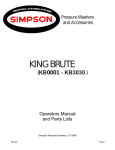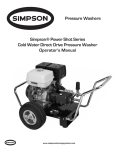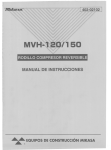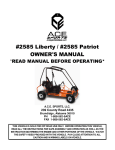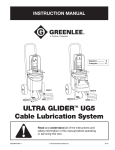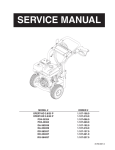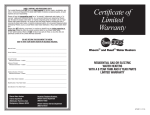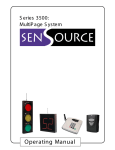Download Simpson PS3000 User's Manual
Transcript
Pressure Washers PS3000 Pressure Washer Operator’s Manual www.simpsoncleaning.com INTRODUCTION Thank you for purchasing this Simpson® pressure washer. For nearly 50 years, Cleaning and Paint Professionals have relied on the superior quality of Simpson Cleaning Systems for their pressure washing needs. Whether you purchased this machine to produce income or simply wanted the best pressure washer on the market today, we truly appreciate your business. Please take time to carefully read this manual and become familiar with your pressure washer. It is extremely important to know the applications, limitations and hazards associated with using pressurized cleaning equipment. Simpson® pressure washers are designed to provide years of service for professional use. Proper use, care, and maintenance of this machine will provide a significant return on your investment. Prior to shipping, this machine was tested to ensure it met the performance and quality standard that Simpson® has long built its reputation. GOOD CLEANING!!! page 2 www.simpsoncleaning.com Table of Contents 1.0 Safety Do’s and Don’ts 4 1.1 - Danger . . . . . . . . . . . . . . . . . . . . . . . . . . . . . . . . . . . . . . . . . . . . . . . . . . . . . . . . . . . . . . . . . . . . . . . . . 4 1.2 - Warning . . . . . . . . . . . . . . . . . . . . . . . . . . . . . . . . . . . . . . . . . . . . . . . . . . . . . . . . . . . . . . . . . . . . . . . . . 4 1.3 - Caution . . . . . . . . . . . . . . . . . . . . . . . . . . . . . . . . . . . . . . . . . . . . . . . . . . . . . . . . . . . . . . . . . . . . . . . . . 4 1.4 - Notice . . . . . . . . . . . . . . . . . . . . . . . . . . . . . . . . . . . . . . . . . . . . . . . . . . . . . . . . . . . . . . . . . . . . . . . . . . 4 2.0 Operating Instructions 5 2.1 - Machine Preparation . . . . . . . . . . . . . . . . . . . . . . . . . . . . . . . . . . . . . . . . . . . . . . . . . . . . . . . . . . . . . . . 5 2.2 - Hose Connections . . . . . . . . . . . . . . . . . . . . . . . . . . . . . . . . . . . . . . . . . . . . . . . . . . . . . . . . . . . . . . . . 5 2.3 - Before Starting Machine . . . . . . . . . . . . . . . . . . . . . . . . . . . . . . . . . . . . . . . . . . . . . . . . . . . . . . . . . . . . 6 2.4 - Starting Gasoline / Diesel Engine Machines . . . . . . . . . . . . . . . . . . . . . . . . . . . . . . . . . . . . . . . . . . . . . 6 2.5 - Pressure Washing . . . . . . . . . . . . . . . . . . . . . . . . . . . . . . . . . . . . . . . . . . . . . . . . . . . . . . . . . . . . . . . . . 7 2.6 - Stopping the Machine . . . . . . . . . . . . . . . . . . . . . . . . . . . . . . . . . . . . . . . . . . . . . . . . . . . . . . . . . . . . . . 7 3.0 Cleaning Nozzles 8 4.0 Cleaning and Applying Detergent 9 5.0 Maintenance 10 5.1 - Pump Crankcase Lubrication . . . . . . . . . . . . . . . . . . . . . . . . . . . . . . . . . . . . . . . . . . . . . . . . . . . . . . . 10 5.2 - Preventative Maintenance . . . . . . . . . . . . . . . . . . . . . . . . . . . . . . . . . . . . . . . . . . . . . . . . . . . . . . . . . 10 6.0 Pump and Unloader Valve Diagnosis 11 7.0 Pressure Washer Limited Warranty 12 www.simpsoncleaning.com page 3 1.0 Safety Do’s and Don’ts This machine produces a high pressure spray, follow these instructions to avoid the risk of injury. 1.1 - Wear proper face protection when operating a pressure washer. Never aim spray gun at yourself, another person, animals or plants Keep hands and feet clear of the cleaning nozzle at all times. Operate in well ventilated areas ONLY! Use ONLY those parts and accessories recommended for these machines. Never operate machine without Belt Guard securely in place. 1.2 - Danger Warning Read all instructions and familiarize yourself with the unit before operating. Read engine manual instructions completely. Always engage the trigger safety lock when the gunvalve is not in use. Relieve the pressure in the system before uncoupling hoses. Never start the machine until the quick couplers are checked to make sure the sleeves are locked. Do not tamper with unloader valve adjustment or alter engine speed. Do not fill the fuel tank when the engine is running or still hot. Do not use on unsupported elevated surfaces (i.e. ladders). Do not try to repair a leak in the hose or connection while the system is under pressure. Do not substitute any component part on this machine. Use ONLY Simpson® replacement parts as originally installed. The use of incorrect parts could cause serious personal injury. Always keep hands and fingers clear of cleaning nozzles. Always relieve the pressure in the system before uncoupling the quick couplers. 1.3 Caution - Use ONLY the cleaning nozzle size designed for your model. - Do not start the machine until water is turned on at the faucet and water is flowing from the end of the extension. 1.4 Notice - Close fuel valve when transporting or storing unit. Let the machine run for several minutes before starting to pressure-wash. Check oil level in engine each time gas tank is filled. Keep air filter clean and engine in tune. Keep incoming water filter clean. Incoming water supply must deliver gallons per minute greater than machine capacity. If questionable, check supply at machine. If supply is insufficient, do not operate from this outlet. For residental use, the outlet closest to the meter tap will usually deliver the highest gallons per minute output. - DO NOT connect to shallow wells used for lawn sprinkling. Connect only to clean city water supply or deep domestic well. page 4 www.simpsoncleaning.com 2.0 Operating Instructions 2.1 Machine Preparation 1. Check oil level in the pump and fill with proper grade of oil (Fig. 2.1-1) (See Pump Maintenance). 2. Check engine oil level and fill with proper grade oil if necessary (Fig. 2.1-2). 3. Check fuel supply (Fig. 2.1-3). Fill if necessary (see engine owner’s manual.) 4. Check the hose, gun, and accessories for damage or wear. Repair or replace if necessary. 5. Check the female quick-couplers for oring seals. Replace if necessary. 2.2 Hose Connections www.simpsoncleaning.com page 5 2.0 Operating Instructions 2.2 Hose Connections (cont.) 1. Connect discharge hose to machine outlet. (Fig. 2.2-1) 2. If optional low pressure downstream, in-line chemical injector is to be used (i.e. a Simpson SC 242 or 252 Series chemical injector) connect the injector at this time (Fig. 2.2-2). For instructions on connections and use, see in-line chemical injector operating instructions 3. Connect gunvalve to discharge hose with quick coupler (Fig. 2.2-3). DO NOT INSTALL CLEANING NOZZLE AT THIS TIME. Quick coupler sleeves must be pushed into locked position to prevent accidental uncoupling (Fig. 2.2-5). 4. Check inlet water filter for blockage then connect water supply hose to machine. Use a 3/4" I.D. or larger hose with standard 3/4" garden hose fittings. (Fig. 2.2-4) Incoming water supply must deliver gallons per minute greater than machine capacity. If questionable, check supply at machine. If supply is insufficient, do not operate from this outlet. For residental use, the outlet closest to the meter tap will usually deliver the highest gallons per minute output. DO NOT connect to shallow wells used for lawn sprinkling. Connect only to clean city water supply or deep domestic well. 2.3 Before Starting Machine DO NOT OPERATE GASOLINE AND DIESEL ENGINES IN ENCLOSED AREAS! OPERATE IN WELL VENTILATED AREAS ONLY! FIGURE 2.3 - GUNVALVE, EXTENSION, & NOZZLE 1. 2. 3. 4. Locate machine on a level plane. Turn on water supply. There should be no nozzle in the extension at this point. Pull gunvalve trigger, allowing air in system to escape. When water flows in a full steady stream, release gunvalve trigger. (Fig. 2.3) 2.4 Starting Gasoline / Diesel Engine Machines 1. Check position of fuel valve, and if closed, open valve. For more detailed information on starting the machine’s engine, see engine instruction manual. 2. Choke: Close choke on carburetor by moving lever in proper direction. If engine is warm or air temperature is high, close choke valve half-way, or keep it open fully. 3. Machines with recoil start: Turn engine ON/OFF switch to the “ON” position. Pull the recoil starter grip lightly until resistance is felt, then pull briskly. Machines without APR (Automatic Pressure Relief): If the engine fails to start after 1 or 2 pulls of the recoil, pressure will build-up in the system. To relieve the pressure squeeze the gunvalve trigger and allow water to flow freely. There should be NO nozzle or obstruction at the end of the extension. 4. After engine starts, open choke gradually. 5. Warm up engine for 3 minutes without load. page 6 www.simpsoncleaning.com 2.0 Operating Instructions 2.5 Pressure Washing WEAR PROPER FACE PROTECTION WHEN OPERATING A PRESSURE WASHER! 1. Select the cleaning nozzle or accessory best suited for the cleaning job. NOTE: Some accessory nozzles function as both a high pressure cleaning nozzle and low pressure chemical injector nozzle (i.e. vari-tip nozzles). See specific accessory nozzle operating instructions for more information. 2. PUT GUNVALVE TRIGGER IN LOCKED POSITION (Fig. 2.4). 3. Connect cleaning nozzle, chemical injector control nozzle, or accessory nozzle or attachment to gunvalve extension quick coupler (Fig. 2.2). 4. Push quick coupler sleeve into LOCKED position to prevent accidental loss of nozzle. Then unlock gunvalve trigger. 5. Check the system for water leaks, fuel leaks, oil leaks, hose kinks, etc. Correct any problems before proceeding. 6. Machine is now ready for operation. HIGH PRESSURE SPRAY CAN PENETRATE THE SKIN AND CAUSE SERIOUS INJURY! NEVER POINT THE SPRAY GUN AT YOURSELF, OTHER PEOPLE, OR ANIMALS. SHOULD SPRAY PENETRATE THE SKIN, SEEK MEDICAL ATTENTION IMMEDIATELY! 2.6 FIG. 2.4 - GUNVALVE SAFETY TRIGGER Stopping the Machine 1. If you have been using a chemical injector, be sure to flush out the chemical by running clean water through the system. 2. Allow machine to run for 1 minute without load to cool before stopping. 3. Operate “STOP” lever or switch to shut off machine (See engine instruction manual). 4. Pull recoil starter until compression resistance is felt. Store the machine in this position to help prevent valve warpage or sticking. 5. Close Fuel Valve. For Electric Models Turn “ON/OFF” switch on machine to the “OFF” position. FAILURE TO CLOSE THE FUEL VALVE ON THE ENGINE CAN CAUSE FUEL LEAKAGE WHEN THE MACHINE IS BEING TRANSPORTED! 6. Turn off water supply. 7. Remove the cleaning nozzle or accessory from the extension quick coupler.. 8. Pull gunvalve trigger to release all pressure in the system, then LOCK THE GUNVALVE TRIGGER (Fig. 2.4). 9. Hoses may now be disconnected from the machine. Failure to release pressure before disconnecting the hose quick coupler will result in the quick coupler o-ring seal blowing out. This o-ring must be replaced before operating machine. www.simpsoncleaning.com page 7 3.0 Cleaning Nozzles There are up to five different quick connect nozzle spray tips, four high pressure and one low pressure “Soap” nozzle. The operator can select a high pressure nozzle spray pattern which best suits the cleaning application. THE BLASTER: (RED) Provides a concentrated spot of high pressure water allowing you to be further from the surface being cleaned and to blast off stubborn material. USE CAUTION with this nozzle as the force available will actually penetrate soft materials or surfaces. Use for reaching high areas such as under eaves. Cleaning tar, chewing gum etc. from sidewalks. Breaking up large areas of loose paint to allow stripping nozzle to get under surface. Removing excess mortar from brick construction. Removing rust flakes from steel. THE STRIPPER: (YELLOW) Provides a narrow fan of concentrated water pressure for removing paint, mildew, etc. By testing several angles between the spray and the surface being worked, the best angle may quickly be identified. Use to remove loose paint from wood, masonry, metal, etc. Remove heavy oxidation, mildew, and marine growth from boats, etc. Clean heavy equipment. THE CLEANER (GREEN) Provides a wider fan for pressure cleaning and rinsing. Use for removing mildew, light to medium oxidation, and dirt from aluminum siding. Rinse stripped areas. General light cleaning in preparation for painting. THE RINSER (WHITE) Provides a wide fan for cleaning and rinsing.Use for general wash-down, light cleaning, rinsing off chemicals used in building restoration, and sweeping driveways and parking areas. THE SOAPER (BLACK) A low pressure nozzle used to apply cleaning solutions. Note: Cleaning solutions cannot be applied with high pressure spray tips (Red, Yellow, Green or White). page 8 www.simpsoncleaning.com 4.0 Cleaning and Applying Detergent IMPORTANT: Use detergents designed specifically for pressure washers. Household detergents could damage pump. To apply detergent follow these steps: 1. Prepare pressure washer detergent solution as required by manufacturer. 2. Place detergent siphon tube/filter into solution. 3. Make sure “SOAPER” nozzle (Black) is installed. 4. Apply cleaning solution to a dry surface, starting at lower portion of areas to be washed and work upward, using long, overlapping strokes. To prevent streaking, DO NOT allow detergent to dry on. IMPORTANT: You must flush the injection system after each use by placing siphon hose into a bucket of clean water, then run pressure washer in low pressure (Black nozzle) for 2 minutes. www.simpsoncleaning.com page 9 5.0 Maintenance 5.1 Pump Crankcase Lubrication Proper pressure washer pump crankcase lubrication will help extend the working life of the machine. Follow these important recommended guidelines: - Change oil after initial 50 hour run-in period. - Simpson pump oil is recommended as the first choice. Change Simpson pump oil at 250 hour intervals. - If Simpson pump oil is not available, a high quality 30 weight non-detergent oil may be used. These oils should be changed every 100 hours. - Direct drive machines should have the pump oil changed at least every 50 hours, regardless of the type of oil used. More frequent oil changes will further enhance the pump’s working life. - Pump oil level can be checked with a dip stick or, for pumps with oil level sight gauges, viewing the sight gauge. Oil level is correct if at the center of the circle. If oil level is low, fill to correct level with recommended oil. DO NOT OVERFILL crankcase! - Some pumps may not have either a dipstick or sight gauge. Oil levels in these pumps can only be checked by draining the crankcase and measuring the oil amount. If oil level is incorrect, replace with the proper amount and type as recommended by the pump manufacturer. 5.2 Preventative Maintenance - Give model and serial number when ordering parts or requesting information. See Section 1.5, Machine Warning Tags and Specification Plate, Fig. 1-4. - Read all instructions and familiarize yourself with the unit before operating. - Keep incoming water filter clean. - Use only nozzles of size furnished with machine. - Drain water from pressure hoses, gun and extension and accessories after use. - Protect pump from freezing. Failure to remove water from the pump in freezing temperatures will result in damaged pump manifold. A winterizing siphon kit (Part No. WK 590-10) is available for this purpose. Using this kit, a 50-50 mixture of ethylene glycol type anti-freeze and water is siphoned into the pump to replace the plain water. - Use ONLY injector of the size and type designed for your model. - DO NOT tamper with unloader valve adjustment or alter engine speed. - DO NOT connect siphon hose to pump inlet for the purpose of siphoning cleaning chemicals through pump. The machine is designed for direct loop up to water supply. - DO NOT exceed 140° F temperature on incoming water supply. Gasoline and Diesel Engines: - Keep air filter clean and engine in tune. - Check oil level in engine each time gas tank is filled. Change oil in the engine at required intervals, and use only recommended grade engine oil. - ALWAYS close fuel valve when transporting or storing unit. - Before storing unit for long periods of time, drain fuel tank and carburetor of all fuel. As an alternative, use a commercially available gasoline preservative additive when storing machine for shorter periods (up to 6 months). Electric Models: - Check the condition of the electrical cord. Damaged cords should be replaced. - DO NOT REMOVE THE GROUND FAULT INTERRUPTER (GFCI) FROM THE ELECTRICAL CORD. page 10 www.simpsoncleaning.com 6.0 Troubleshooting PROBLEM N o P ressure Low P ressure P ulsation or H oses V ibrating W ater Leak ing U nder P um p W ater in P um p O il PROBABLE CAUSE SOLUTION B rok en B elts (if A pplicable) Im proper B elt T ension (if A pplicable) R eplace B elts A djust B elt T ension C logged Inlet W ater F ilter C logged N ozzle C lean or R eplace W ater Inlet F ilter C lean D ebris from N ozzle W orn or Incorrect N ozzle Im proper B elt T ension (if A pplicable Im proper E ngine R .P .M . R eplace N ozzle w ith C orrect S ize Inadequate W ater S upply A djust B elt T ension C onsult S ervice C enter C heck W ater S upply and C lean Inlet F ilter Inadequate W ater S upply P artially C logged N ozzle D ebris in P um p V alves Incorrect N ozzle S ize C heck W ater S upply and Inlet W ater F ilter C lean or R eplace N ozzle C onsult S ervice C enter Install C orrect S ize N ozzle W orn P lunger S eals W orn or D am aged P lungers P um p R unning D ry C onsult S ervice C enter C onsult S ervice C enter C heck W ater S upply W orn P um p S eals W orn or D am aged P lungers C onsult S ervice C enter C onsult S ervice C enter C ondensation in P um p C rank case C hange O il O il Level T oo H igh P um p O il Leak W rong O il T ype O perating on U nlevel S urface T ire P ressure T oo Low or F lat D rain O il and F ill to P roper level D rain O il and F ill w ith C orrect O il S im pson 30 W T N on-D etergent M ove T o Level S urface Inflate T ire or R epair Leak R ecoil S tarter H ard to P ull P ressure B uilt up in S ystem P ull T rigger w hile S tarting U nit E ngine D ies W hen T rigger is R eleased U nloader V alve is B rok en or M isadjusted C onsult S ervice C enter www.simpsoncleaning.com page 11 7.0 Pressure Washer Limited Warranty At SIMPSON CLEANING SYSTEMS, we only distribute top quality industrial / commercial / personal pressure washers that are designed for heavy-duty use, maximum reliability, durability, and long life. Our pressure washers are built for all duty applications and steady use due to higher quality levels. The manufacturer of this product agrees to repair or replace designated parts that prove defective within the warranty period of one (1) year listed in the chart below. Specific limitations/extensions and exclusions apply, and are listed in the chart below. This warranty covers defects in material and workmanship and not parts failure due to normal wear, depreciation, abuse, accidental damage, negligence, improper use, maintenance, or storage. To make a claim under the terms of the warranty, all parts said to be defective must be available or returned (if requested) to SIMPSON CLEANING SYSTEMS designated Warranty Service Center for warranty inspection. The judgments and decisions of the Warranty Service Center concerning the validity of warranty claims are final. These warranties pass through to the end user. As a factory authorized and trained Warranty Service Center the factory will honor the terms of all component warranties and satisfy claims of the appropriate warranty provisions. Normal wear items include, but are not limited to, Valves and Seals, which are not covered by this warranty. This Warranty replaces all other warranties, express or implied, including without limitation any warranties of merchantability or fitness for a particular purpose and all such warranties are hereby disclaimed and excluded by the manufacturer. The Manufacturer’s warranty obligation is limited to repair and replacement of defective products as provided herein and the Manufacturer shall not be liable for any further loss, damages, or expenses – including damages from shipping, accident, abuse, acts of God, misuse, or neglect. Neither is damage from repairs using parts nor purchased from the manufacturer or alterations performed by non-factory authorized personnel. Failure to install and operate equipment according to the guidelines put forth in the instruction manual shall void warranty. This warranty does not cover the following: machines used for rental purposes, damage resulting from shipping (claims must be filed with freighter), accident, abuse, act of God, misuse, or neglect. Neither is damage from repairs or alterations performed by non-factory authorized personnel or failure to install and operate equipment according to the guidelines put forth in the instruction manual. The manufacturer will not be liable to any persons for consequential damage, for personal injury, or for commercial loss. page 12 www.simpsoncleaning.com 7.0 Pressure Washer Limited Warranty (cont.) Parts / Components CAT PUMPS® Warranty Period and Details Two (2) years on pump (workmanship or defects on material. Lifetime on forged brass manifold against freezing. Warranty does not apply to failures on other pump parts due to: Freight damage Freeze damage Damage caused by parts or accessories not obtained from / or approved by Simpson Normal wear of moving parts or components affected by moving parts. Engines Covered by engine manufacturer warranty. See engine manual. Machine Frame One (1) year from date of purchase. Accessories Ninety (90) days. Includes tips, guns, wands www.simpsoncleaning.com page 13 710xxxx 06/10 rev0 ©2010, Simpson Cleaning Systems, LLC. All Rights Reserved. Specifications subject to change without notice. 1825 Greenleaf Avenue Elk • , Grove Village, IL 60007 : • Phone (847) 348-1500 • Fax: (847) 882-7229 page 14 www.simpsoncleaning.com















